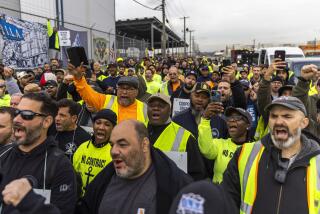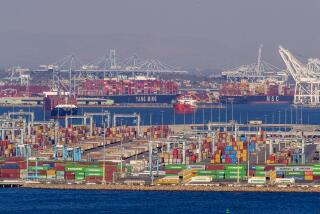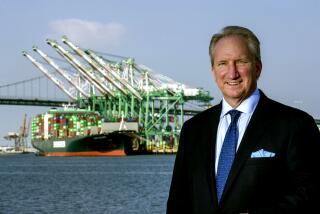Ocean shipping lines cut speed to save fuel costs
- Share via
On the high seas, full speed ahead is being replaced by slow and steady.
Eager to cut fuel costs, ocean shipping lines have ordered their sea captains to throttle back the engines for what is quaintly known in the industry as “slow steaming.” In some cases, freighters are taking as many as 15 days to make a Pacific crossing that used to take 11 days.
Sailors grumble that it’s making long voyages even more tedious. Some ships are crawling at just 12 to 14 knots, or about 14 to 16 mph. Many cargo ships are capable of moving at nearly twice that speed.
“After two weeks, it’s just so monotonous,” said Daniel Ticer, a 58-year-old boatswain who was hanging out between sailings at the International Seafarers Center in Long Beach. “They try to add entertainment onboard the ship, more movies, but it’s tough,” said Ticer, who lives near Fresno when he isn’t at sea.
There is no relief in sight, however. Ocean shippers lost an estimated $22 billion in 2009, analysts say, largely because of the global economic downturn. Saving on fuel is one way to cut losses.
“Companies are more focused on reducing costs, not speed of delivery, and the trend will continue even after the global economy comes back,” said Asaf Ashar, who heads the National Ports and Waterways Institute in Washington. Nearly all of the world’s shipping lines are using slow steaming at least part of the time, he said.
Copenhagen-based A.P. Moeller-Maersk, the world’s biggest ocean cargo line, is a major convert. Maersk, which has a fleet bigger than the U.S. Navy, swung to a $639-million profit in the first three months of the year, the most recent quarter reported, from a $373-million loss in the same period last year. The sharp improvement came with the help of a 9% saving in fuel consumption because Maersk’s ships slowed down.
“We continue our slow steaming and fuel-saving activities,” said Nils Smedegaard Andersen, Maersk’s group chief executive, who has put “basically all ships on slow steaming.”
Such cost-saving ploys, Andersen said in a conference call with investors and analysts, “is what will make us competitive going forward.”
In terms of reducing fuel use, a cargo ship is like a car, only on a huge scale.
A typical 8,000-container ship traveling at 21 knots will burn 125 metric tons of fuel to go 500 nautical miles, said Lee Kindberg, environmental director for Maersk North America. The same ship will need just 80 metric tons of fuel to travel the same distance if the speed drops to 15 knots.
For the 6,310-nautical-mile voyage from Hong Kong to Long Beach at current bunker fuel prices, that’s a potential savings on fuel of $250,000, according to Maersk.
Of course, slow sailing also increases crew costs. But there are still other cost benefits to slowing down. For one thing, it allows carriers to keep more ships in use, avoiding the expense of mothballing.
As international trade plummeted in 2008 and 2009, shipping line executives found themselves burdened with far more ships than they needed. Ship-breaking centers dismantled a record 208 vessels in 2009, more than twice the previous record in 2008. More than 10% of the world’s cargo container fleet was idled, turning some of the world’s waterways into floating parking lots.
During last year’s holiday shipping season, about 500 vessels were anchored east of Singapore’s giant port. Hundreds more sat unneeded at a former U.S. Navy base at Subic Bay in the Philippines. On the Fal River in Cornwall, England, tourists accustomed to seeing castles and other historic British sights found unemployed ships added to the mix.
“Slow steaming absorbs a significant portion of the world fleet and should improve reliability,” said Wolfgang Freese, president of Hapag-Lloyd America, the U.S. arm of the Hamburg, Germany, conglomerate that ranks sixth in the world among ocean shipping lines. “We see no, or very little, risk to the supply chain,” he told a recent shipping conference in Long Beach.
The customers aren’t so sure. Importers and exporters around the world worry that deliveries will suffer as more carriers ease off the throttle.
Jean Louis Cambon heads the global shipping operation of French tire maker Michelin, one of the European Union’s biggest shippers, and he has been a vocal critic of the practice.
“This has to be one of the few sectors of industry that believes it can reduce service quality while simultaneously increasing prices,” Cambon said recently in his inaugural speech as chairman of the European Shippers’ Council’s Maritime Transport Council, an influential group representing companies that use transport services.
Some supply experts say complaints have been muted because of the weakness of the economic recovery. But Jon DeCesare, chief executive of World Class Logistics Consulting Inc., predicts that concerns will be heightened once consumers are spending more freely.
“When the economy picks up, the last thing retailers are going to want are unexpected delays. They cannot afford to be out of stock,” DeCesare said.
Small importers, such as Los Angeles-based Megatoys, are particularly concerned. Megatoys Chief Executive Charles Woo, who uses about 2,000 cargo containers a year, said he depended on timely deliveries of products to fill Easter baskets and Christmas stockings.
“I’m a small guy. My competitive advantage is turning around products fast,” Woo said. “If they are going to be saving money, are they going to offer us lower rates?”
Nonetheless, the slow-steaming trend is being applauded by environmentalists, who for years have blasted ocean cargo shipping as one of the world’s worst sources of greenhouse gas emissions.
A recent report by Dutch environmental research group CE Delft, commissioned by the European organization Seas at Risk, said slowing down container ships, bulk carriers and tankers could reduce emissions 30% from 2010 through 2012.
Some sailors don’t mind the tedium of slow steaming as long as they’ve got a job.
“I used to get a month between jobs, two tops, but I recently had more than four months without work,” said Gimbi Valenzuela, a 39-year-old seaman from Manila.
“Lots of ships were laid up. Lots of people without work. My pay is down $140 from $1,540 a month, and the trips are longer, but I can’t complain. I’m lucky to have work.”
More to Read
Inside the business of entertainment
The Wide Shot brings you news, analysis and insights on everything from streaming wars to production — and what it all means for the future.
You may occasionally receive promotional content from the Los Angeles Times.











